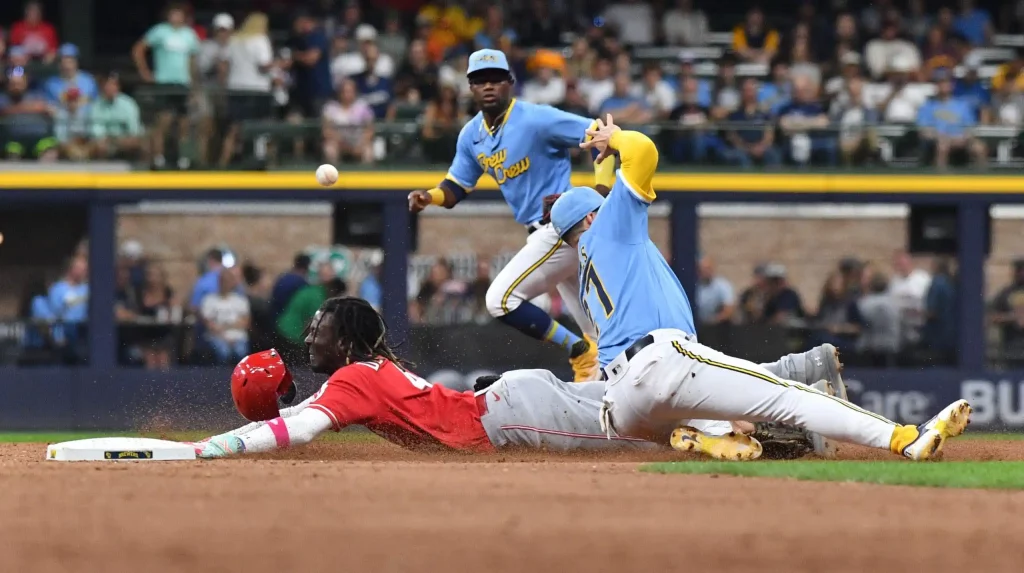MLB Running Lane Rule Explained! To Be Banned In The Upcoming Season?
Running lanes in MLB have long been contentious, and they may expire in 2024. The Joint Competition Committee of the league has formally suggested that the regulation be lifted.
MLB Running Lane Rule Explained! To Be Banned In The Upcoming Season?
A hitter racing from home base to first cannot impede a throw, if one is not familiar with the original regulation. The batter may be called out if interference is detected.
The group has now formally submitted a proposal, which has begun the mandatory 45-day review process. Though not the lane itself, we could have witnessed the end of the running lane rule as we know it by Christmas.
Peoples keep saying Zeke is the same guy but he just isn’t seeing running lanes like he used to. On the run he turns his shoulders immediately which takes away his ability to read the MLB and unable to stick his foot in the ground for the open cutback lane. pic.twitter.com/MZ4r2H6dSm
— Cowboys Fan Talk (@CowboysFanTalk) December 11, 2019
To get to first base, the hitter can, nonetheless, step, stride, or reach out of the three-foot lane. This has left a lot of room for interpretation by the regulation and confounded players, coaches, and even umpires during the heat of the moment.
The suggestion is to give the runner the whole width of the first base to home plate dirt route.
I’m relieved there is no longer any interpretation, as one seasoned manager stated. Grit is beneficial. Grass is not good.
@ MLB umpires and running lane rules. pic.twitter.com/yZrSlxXVGX
— Broseph (@Broseph_2014) October 7, 2017
Before games, the running path would still be chalked. According to an MLB insider, the lane would be required for plays where the ball is in foul area, such dropped third strikes, in order to prevent runners from going too far beyond the line.
The Competition Committee, consisting of eleven members—six MLB personnel, four players, and one umpire—has recommended various rule modifications, the most of which have to do with play tempo. Among these changes is the revised running lane. A proposal cannot be put to a vote prior to the 45-day consultation period.
Ah, the running lane…. #MLB pic.twitter.com/fu4cmvvXRa
— Doug Glanville (@dougglanville) October 11, 2021
The most recent CBA talks resulted in the formation of the Competition Committee. Any official rule modification proposal is welcome from the commissioner’s office or any member of the committee. After the 45-day review period, a final vote is held, and in order to succeed, it must receive the majority of votes. Any rule modification that the committee approves needs to be publicized prior to the players’ required spring training reporting date.
There are several proposed rules for the 2024 season, the running lane regulation being only one of them. Slashing the pitch timer is one of the biggest proposed regulation changes.
The running lane to 1st base in MLB. The lane is in foul territory. The base is in fair territory. To get to 1st base in the quickest way, you need to run in fair territory. But if you affect the throw (or get hit by it) you are called out. Makes no sense. #NeverLettingThisGo 😁 https://t.co/HMRvViDW5O
— Andy Gretz (@AndyGretz1) February 3, 2021
With runners on base, the league wants to reduce the pitch period from 20 to 18 seconds. This season’s games were successfully shortened by the pitch timer, and the league would want even shorter contests.
An additional proposed regulation for the next season would prohibit infielders from obstructing bases. This might be harmful not just for the runners but also for the infielders. Players like Francisco Lindor and Corey Seager would be limited as a result.
Which of these new regulations is implemented for the upcoming season will be interesting to see.
MLB’s Controversial Running Lane Rule Could Die in 2024 https://t.co/uUkLKxEfKK via @SInow
— Luis Yunko Olmedo (@LuisYunko) December 2, 2023
Reduce mound visits from five to four in a nine-inning game.
Please remove the regulation that permits an uncharged mound visit each time a pinch hitter is introduced while we’re at it. There are usually just four batters on a team’s bench. Pregame meetings are the ideal opportunity to practice pitching those four men; the game should not be stopped automatically or needlessly. Once more, let the participants solve the puzzle.
Infielders cannot block bases.
We appreciate Whit Merrifield’s sensible suggestion. This has to do with player safety. Why can’t catchers use their legs to block bases when infielders can?
https://twitter.com/BeauKnows55/status/1189609367030652928
Pitchers who have runners on must work out of the stretch.
The idea was inspired by pitchers that combine components of the stretch and windup positions with their “hybrid” delivery, which causes uncertainty when there is a runner at third base.
With two outs and a runner on third, many pitchers like the windup because it is more efficient and/or comfortable for them. MLB shouldn’t impose laws governing a pitcher’s decision to compete, particularly in cases when the issue isn’t serious enough to require attention.
As you can clearly see here, Dodgers' Chris Taylor's intent to lower his shoulder, veer into the catcher (when he had a lane wide open) — in attempt at blowing #Padres' C, Austin Hedges up. So many dirty plays by the dodgers this year against SD, has to stop. @heyscan @MLBPAA pic.twitter.com/FnAIZn9lrq
— Mickey Koke (@mickeykoke) August 12, 2020
FOR MORE SPORTS COVERAGE-
Lawrence Taylor Explains Why He Wouldn’t Make It In Modern NFL


